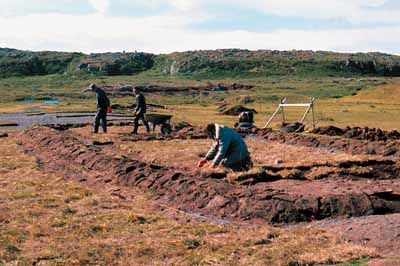Port au Choix National Historic Site of Canada
Port au Choix, Newfoundland and Labrador

View of excavations.
© Parks Canada Agency / Agence Parcs Canada
Address :
Port au Choix, Newfoundland and Labrador
Recognition Statute:
Historic Sites and Monuments Act (R.S.C., 1985, c. H-4)
Designation Date:
1970-06-08
Event, Person, Organization:
-
Maritime Archaic culture
(People, group)
-
Groswater Palaeo-Eskimo culture
(People, group)
-
Dorset Palaeo-Eskimo culture
(People, group)
Other Name(s):
-
Port au Choix
(Designation Name)
-
Phillips Garden Site
(Other Name)
Research Report Number:
1970-ATT, 2001-032, 1982-007
DFRP Number:
01688 00
Description of Historic Place
Port au Choix National Historic Site of Canada consists of two exceptionally rich pre-contact archaeological sites located at Port au Choix Newfoundland where the Port au Choix and Point Riche peninsulas jutting into the Strait of Belle Isle are joined by a narrow isthmus. Constructed from approximately 4,400 BCE to 1,300 BCE, both sites are located on long, flat raised terraces running beside the water. The designation refers to both a Maritime Archaic cemetery in the form of a burial terrace overlooking Back Arm and also the Phillip’s Garden Palaeo-Eskimo habitation site; a flat grassy place situated on the outer shore of the Point Riche Peninsula where land forms and vegetation indicate the remnants of two early settlements scattered over an area of some two hectares.
Heritage Value
Port au Choix was designated a National Historic Site of Canada because: it includes a large cemetery that consisted of exceptionally rich and well-preserved remains of the Maritime Archaic culture whose people buried their dead in this place, located on what was, at the time, an island, from about 4,400 to 3,300 years ago; the cemetery greatly enhances understanding of the marine-oriented technology, economy and spiritual culture of the Maritime Archaic people; the site included a major settlement location at Phillips garden occupied by two Palaeo-Eskimo cultures, Groswater (2,800-1,900 BCE) and Dorset (2,000-1,300 BCE); and, the exceptionally well-preserved remains of tools, weapons and discarded food bones from this settlement provide a new appreciation of the material and intellectual cultures of the Palaeo-Eskimo people.
The heritage value of Port au Choix National Historic Site of Canada resides in the site itself and in the exceptional rarity, richness and quality of the archaeological evidence its two designated places contain. Considerable archaeological investigation has occurred on these sites under the auspices of Parks Canada and the Province of Newfoundland and Labrador.
Source: Historic Sites and Monuments Board of Canada, Minutes, 1970, 1982, and November 2001.
Character-Defining Elements
Key elements that contribute to the heritage character of the site include: the location of the sites in close proximity to the sea; the siting of both places on terraces above a beach; the open, mostly grassy vegetation of both sites; the remaining undeveloped landscape of the terrace on which the Maritime Archaic site is located; the footprints, forms and distribution of space of the two burial areas bisected by a stream on the Maritime Archaic site, and of the remains of dwellings and middens as indicated by variations in ground level and vegetation on the Phillip’s Garden site; the location and nature of grave sites on the Maritime Archaic site; the physical integrity of archaeological artifacts on the Phillip’s Garden site; knowledge embodied in artifacts removed from these sites and stored by the Province of Newfoundland and Labrador, including the excavation reports; vegetation and land forms indicating the scale and boundaries of each site; vegetation, land forms and artifacts (such as grave stones) indicating the past use of space on each site; the geology of the site including evidence of the limestone geology that has expedited preservation of these sites, and of geological evolution on both sites over time such as indications that the Maritime Archaic burial area was once an island; evidence of the change in sea-level over time and of the sea conditions that have attracted an abundance of marine life to this area for thousands of years; viewscapes from the Maritime Archaic burial area to other burial sites on the same terrace, and to other burial terraces; viewscapes from the Phillip’s Garden site to the surrounding natural terrain; viewscapes from both sites to the sea.